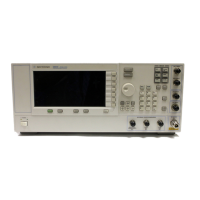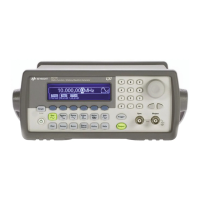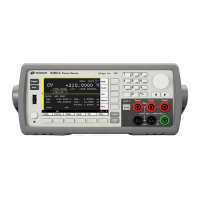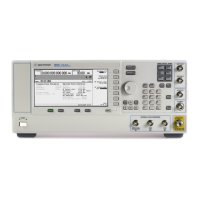Keysight CXG, EXG, and MXG X-Series Signal Generators Service Guide 187
RF Assembly
A3 RF Assembly Overview
The CXG and EXG A3 RF assemblies are basically the same thing. However,
they are programmed differently.
The difference between the A3 RF assemblies in the CXG, EXG, and MXG RF
instruments is in the Reference and Synthesizer sections.
The difference between the A3 RF assemblies in the EXG and MXG Microwave
instruments is in the Synthesizer section.
The difference between the A3 RF assemblies in the RF and Microwave
instruments is in the RF Output and Automatic Level Control sections.
Detailed information on these differences can be seen in the block diagrams in
Chapter 13, “Block Diagrams,” and will be discussed in the descriptions of
these sections.
Self Tests
There is an extensive number of Self Tests for the A3 RF assembly. All the 100,
200, 300, 400, 500, and 600 series Self Tests are for the A3 RF assembly. See
Chapter 4, “Self Test,” for more information on these tests. The A3 RF
assembly Self Tests will also be discussed in the “A3 RF Assembly
Troubleshooting” section later in this chapter.
Calibration Data
Calibration data for the assembly is stored on the A3 RF assembly. This is data
that was either written to the assembly when the instrument was produced at
the factory or by an adjustment in the performance verification and adjustment
software. Also, replacement A3 RF assemblies come from the factory with
calibration data stored in them. See “Calibration Data” in Chapter 3,
“Instrument Information and Calibration Data,” for more information on the
instrument calibration data.
Reference Section
There are two difference Reference sections used in the five different A3 RF
assemblies. All of them provide the following reference signals:
— 10 MHz to rear panel 10 MHz OUT
— 50 MHz to synthesizer FracN phase detector
— 100 MHz to A2 Vector BBG for vector instruments
— 1 GHz to RF output Het Band mixer LO
For discussion purposes, it is assumed that RF instruments all have the
option to operate up to 6 GHz (Option 506) and microwave instruments all
have the option to operate up to 40 GHz (Option 540). The frequency
range of each instrument may vary, but the operational theory up to the
actual frequency range will be the same.

